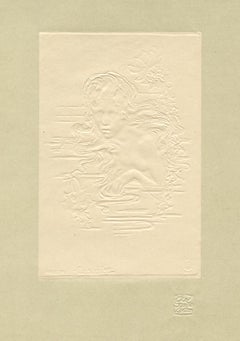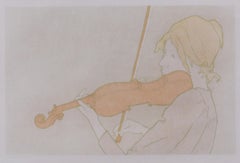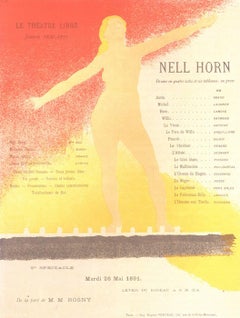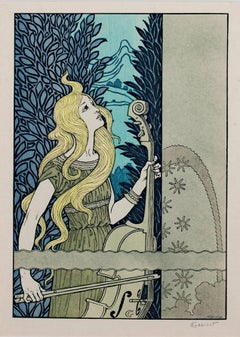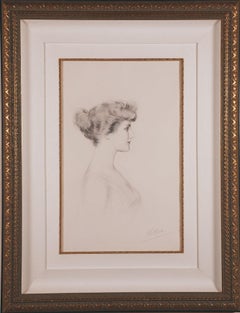Alexandre Charpentier Art
French, 1856-1909
Alexandre Charpentier was a French sculptor, medalist, craftsman and cabinet-maker. He experimented with a wide variety of formats and materials—tin, marble, wood, leather and terra cotta work, the latter executed by ceramic artisan Emile Müller. Charpentier designed many sets of furniture. Many of his custom designs for fixtures (doorknobs, door plates, window handles and the like) were subsequently mass-produced and commercially sold. Several of Charpentier's works are part of the Musée d'Orsay collection.
to
4
1
3
1
2
2
Overall Height
to
Overall Width
to
4
3
2
2
1
1
1
1
1
1
1
1
1
4
5
6,855
3,168
2,517
1,217
3
1
Artist: Alexandre Charpentier
embossed engraving
By Alexandre Charpentier
Located in Henderson, NV
Medium: embossed engraving. Printed in 1897 and published in London for The Studio. Image size: 5 x 3 3/8 inches (130 x 85 mm). Sheet size: 11 x 7 5/8 inches (282 x 193 mm). This imp...
Category
1890s Art Nouveau Alexandre Charpentier Art
Materials
Engraving
La Fille au Violon
By Alexandre Charpentier
Located in Fairlawn, OH
La Fille au Violon
Color lithograph, gypsograph with embossed publisher's stamp
Signed and numbered in ink (see photo)
From: L'Estampe Originale, Paris, Vol. VII
Published by Andre M...
Category
1890s Art Nouveau Alexandre Charpentier Art
Materials
Lithograph
"Grande Tuilerie d’Ivry" from Les Maitres de l'Affiche
By Alexandre Charpentier
Located in Hinsdale, IL
CHARPENTIER, ALEX
(1856 -1909)
"Grande Tuilerie d’Ivry"
Original lithograph from "Les Maitres de L'Affiche" series
Printed by Imprimerie Chaix, Paris
Bearing MDL stamp lower right, issue # 33, 1898. Plate #131
Unframed Size: 11 3/8 x 15 3/4”The
"Les Maitres de l'Affiche" series was offered as a subscription series to collectors every month for 60 months, from December 1895 through November 1900. The "Maitres de l'Affiche," were issued as separate numbered sheets, referred to as "plates". They were numbered, with the printers name "Imprimerie Chaix," in the margin at the bottom left hand corner, "PL.1" to "PL.240." In the margin at the bottom right hand corner of each, is a blind embossed stamp from a design of Cheret's. The smaller format and the fact the "Maitres" were a paid subscription series, allowed Imprimerie Chaix to use the latest state of the art printing techniques, not normally used in the large format posters due to cost. A very high quality of paper was used, where as the large format posters were printed on lesser quality newsprint, due to cost and a short expected life span. This explains why the quality of the printing, in the "Maitres de l'Affiche," usually far exceeds that of their larger counterparts. The text reads "Great Tileworks of Ivry, founded in 1854, Ivry-Port near Paris; the largest ceramics factory in the world for building, industry and art productions; Emille Muller stoneware; execution of works by masters of statuary; architectural facings; decorative sculpture; showroom and salesroom, 3 rue Halevy; the only tile able to bear the names Muller and Ivry; (tiles) guaranteed against frost" Given the commission for an extremely text heavy poster, the artist executes a masterful design. The angelic young boy holds the wares of this famous ceramics factory, against an abstract background awash in organic green hues. The handling of the immense text that flows from top to bottom in every available space shows great artistic skill, as the overall beauty of the design is intact. In 1989 the Metropolitan Museum of art acquired a stoneware plaque...
Category
1890s Art Nouveau Alexandre Charpentier Art
Materials
Lithograph
Nell Horn. Program pour Le Theatre Libre. Saison 1980-91. May 25 1891
By Alexandre Charpentier
Located in New York, NY
Embossing (gaufrage) with typographical color printing. Fine impression with good embossing on simili-japon paper, printed to the edges of the sheet (as issued). The combination of techniqes is unusual and may be unique.
Ref: Artistes et Theatre d'Avant-Garde Programmes illustres Paris 1890-1900 Aitken p 22 pl 11; Artists and the Avant-Garde Theatre in Paris 1887-1890 Boyer p.44 pl 9.
Alexandre Charpentier was French sculptor, medalist, craftsman, and cabinet-maker. He experimented with a wide variety of formats and materials—tin, marble, wood, leather, and terra cotta work, the latter executed by ceramic artisan Emile Müller...
Category
1890s Art Nouveau Alexandre Charpentier Art
Materials
Lithograph
Related Items
"Woman with Cello, " Wood Engraving signed by Gillot after Eugene Grasset
By Eugène Grasset
Located in Milwaukee, WI
"Woman with Cello" is a wood engraving by Gillot after Eugene Grasset. The artist signed the piece in the lower right. It depicts a woman with long fl...
Category
1890s Art Nouveau Alexandre Charpentier Art
Materials
Engraving
"Madame Georges Menier" Portrait, by Paul Cesar Helleu
By Paul César Helleu
Located in Hinsdale, IL
HELLEU, PAUL CÉSAR
(1859 -1927)
"MADAME GEORGES MENIER"
Montesquiou XXI
Drypoint in colors, c. 1900
Signed in pencil, lower right
Printed on wove paper
Full...
Category
Early 20th Century Art Nouveau Alexandre Charpentier Art
Materials
Drypoint
H 38.5 in W 28.5 in D 2 in
Original vintage poster "Truth" weekly magazine art nouveau lithograph
Located in Spokane, WA
Original vintage.poster: TRUTH CHRISTMAS. NOTE that this is the turn of the century original poster and is Not a magazine cover. The poster for a gossip magazine focusing on New...
Category
1890s Art Nouveau Alexandre Charpentier Art
Materials
Lithograph
H 20.5 in W 13.5 in D 0.05 in
"LA CHAINE SIMPSON" by Toulouse-Lautrec from Les Maitres de l'Affiche
By Henri de Toulouse-Lautrec
Located in Hinsdale, IL
TOULOUSE-LAUTREC, HENRI DE
(1864-1901)
"LA CHAINE SIMPSON"
Original lithograph from "Les Maitres de L'Affiche" series
Printed by Imprimerie Chaix, Paris
Bearing MDL stamp lower right, from issue #60, 1900. Plate #238
Unframed Size: 11 3/8 x 15 3/4”
The "Les Maitres de l'Affiche" series was offered as a subscription series to collectors every month for 60 months, from December 1895 through November 1900. The "Maitres de l'Affiche," were issued as separate numbered sheets, referred to as "plates". They were numbered, with the printers name "Imprimerie Chaix," in the margin at the bottom left hand corner, "PL.1" to "PL.240." In the margin at the bottom right hand corner of each, is a blind embossed stamp from a design of Cheret's. The smaller format and the fact the "Maitres" were a paid subscription series, allowed Imprimerie Chaix to use the latest state of the art printing techniques, not normally used in the large format posters due to cost. A very high quality of paper was used, where as the large format posters were printed on lesser quality newsprint, due to cost and a short expected life span. This explains why the quality of the printing, in the "Maitres de l'Affiche," usually far exceeds that of their larger counterparts. "In her recent excellent biography of Lautrec, Julia Frey indicates that 'Henry, the frustrated athlete, was compulsively familiar with the vocabulary and technical aspects of a variety of sports in which he could participate as a spectator: horse and bicycle racing, wrestling, yachting, bullfighting. He watched them all with the same intensity that he watched a line of dancers or a circus bareback rider, attracted by the beauty of movement, but also by the smells, sounds and excitement of the spectacle (Frey, p.353) His 'insider' knowledge of the cycling field shows up abundantly in this poster for the French agent of the Simpson bicycle chain company. In the foreground is the champion cyclist Constant Huret. In the background are Tristan Bernard, the sports impresario who was a close friend of Lautrec, with Louis Bougle, the French agent who adopted the name 'Spoke.' A touch of levity is added by what appears to be a 'bicycle-built-for-ten' in the upper-left corner, in fact it's two five-seaters, known at the time as 'quints.'"(Rennert, PAI-XXII, 35)Henri de Toulouse-Lautrec came from an aristocratic background, having been born the son of an earl.Even as a schoolboy he showed a talent for drawing. By 14 he had suffered two horse back riding accidents, combined with a serious bone disease which eventually left him crippled for life. His body continued to grow but not his legs, he would remain only five feet tall and suffer pain and embarrassment his entire life.At the age of 18, Lautrec moved to Montmartre in Paris to study art seriously. He worked with artists Louis Anquentin, Emile Bernard, Degas, Van Gogh and others. He became a frequenter of the the cafes, cabarets and brothels of the neighborhood, drawing from them inspirations for his artistic themes. As the artist's stature grew, several magazines wanted to publish his work, including Le Rire. His subjects, as well as street life, included some of the most famous music-hall performers, with whom he became friends, such as Yvette Guilbert, La Goulue Jane Avril, May Milton, May Belfort...
Category
1890s Art Nouveau Alexandre Charpentier Art
Materials
Lithograph
Henri de Toulouse-Lautrec"LA CHAINE SIMPSON" by Toulouse-Lautrec from Les Maitres de l'Affiche, 1900
H 18.5 in W 21.75 in D 1 in
Couple Under a Tree
By Elyse Ashe Lord
Located in New York, NY
Elyse Ashe Lord (1900-1971), Couple Under a Tree, c. 1930, color etching, soft ground, drypoint; signed lower right in pencil and numbered by the artist lower left. In very good condition, the full sheet, 11 3/4 x 12 1/4, the sheet 17 x 16 inches.
A fine impression, with strong colors and plate tone. Printed on a light laid ivory Japan...
Category
1930s Art Nouveau Alexandre Charpentier Art
Materials
Drypoint, Etching
Flirt Biscuits by Alphonse Mucha
By Alphonse Mucha
Located in Hinsdale, IL
ALPHONSE MUCHA
(1860 – 1939)
Flirt Biscuits
Rennert/Weill 72
Lithograph in colors c. 1900
Signed in stone, lower right margin
Image: 24” x 11”, Paper: 25 ¼” x 11 ¾”
F...
Category
Early 1900s Art Nouveau Alexandre Charpentier Art
Materials
Lithograph
Original Antar, French Opera Theater vintage stone lithograph opera poster
Located in Spokane, WA
Original vintage French opera poster: Antar. Artist: Georges Rochegrosse. Stone lithograph linen backed in very fine condtion, ready to fra...
Category
1920s Art Nouveau Alexandre Charpentier Art
Materials
Lithograph
Georges RochegrosseOriginal Antar, French Opera Theater vintage stone lithograph opera poster , 1921
H 34.25 in W 26.25 in D 0.05 in
Lorenzaccio - Sarah Bernhardt (after) Alphonse Mucha Poster, 1969
By Alphonse Mucha
Located in New York, NY
These beautiful and colorful lithographic posters were hand reproduced by the Mourlot Studio's Master Printer Henri Deschamps in 1969. They are not to be mistaken with later cheap di...
Category
1960s Art Nouveau Alexandre Charpentier Art
Materials
Lithograph
Original Aux Laines Ecossaises vintage French antique poster yarn
Located in Spokane, WA
Original 1928, AUX LAINES ECOSSAISES antique stone lithograph poster, created by the artist R. Hurwic. Archival linen backed and ready to fr...
Category
1920s Art Nouveau Alexandre Charpentier Art
Materials
Lithograph
H 47 in W 31.5 in D 0.05 in
Miss Taylor
By Paul César Helleu
Located in Fairlawn, OH
Miss Taylor
Drypoint, c. 1900
Signed in pencil lower left (see photo)
Small edition, about 10
Very rich impression, full of burr
Condition: Excellent
Image size: 21-1/4 x 13-1/4"
Sheet size: 25 3/8 x 18 5/8"
Reference: Montesquiou XII
Paul César Helleu was born in Vannes, Brittany, France. His father, who was a customs inspector, died when Helleu was in his teens. Despite opposition from his mother, he then went to Paris and studied at Lycée Chaptal. In 1876, at age 16, he was admitted to the École des Beaux-Arts, beginning academic training in art with Jean-Léon Gérôme. Helleu attended the Second Impressionist Exhibition in the same year, and made his first acquaintances with John Singer Sargent, James McNeill Whistler, and Claude Monet. He was struck by their modern, bold alla prima technique and outdoor scenes, so far removed from the studio. Following graduation, Helleu took a job with the firm Théodore Deck Ceramique Française hand-painting fine decorative plates. At this same time, he met Giovanni Boldini, a portrait painter with a facile, bravura style, who became a mentor and comrade, and strongly influenced his future artistic style.
When he was 18 years old, Helleu established a close friendship with John Singer Sargent, four years his senior, that was to last his lifetime. Already becoming established, Sargent was receiving commissions for his work. Helleu had not sold anything, and was deeply discouraged almost to the point of abandoning his studies. When Sargent heard this, he went to Helleu and picked one of his paintings, praising his technique. Flattered that Sargent would praise his work, he offered to give it to him. Sargent replied, "I shall gladly accept this, Helleu, but not as a gift. I sell my own pictures, and I know what they cost me by the time they are out of my hand. I should never enjoy this pastel if I hadn't paid you a fair and honest price for it." With this he paid him a thousand-franc note.
Helleu was commissioned in 1884 to paint a portrait of a young woman named Alice Guérin (1870–1933). They fell in love, and married on 28 July 1886. Throughout their lives together, she was his favourite model. Charming, refined and graceful, she helped introduce them to the aristocratic circles of Paris, where they became popular fixtures.
On a trip to London with Jacques-Émile Blanche in 1885, Helleu met Whistler again and visited other prominent artists. His introduction to James Jacques Tissot, an accomplished society painter from France who made his career in England, proved a revelation. In Tissot, Helleu saw, for the first time, the possibilities of drypoint etching with a diamond point stylus directly on a copper plate. Helleu quickly became a virtuoso of the technique, drawing with the same dynamic and sophisticated freedom with his stylus as with his pastels. His prints were very well received, and they had the added advantage that a sitter could have several proofs printed to give to relations or friends. Over the course of his career, Helleu produced more than 2,000 drypoint prints.
Soon, Helleu was displaying works to much acclaim at several galleries. Degas encouraged him to submit paintings to the Eighth Impressionist Exhibition in May and June 1886. The show was installed in a Paris apartment at 1 rue Laffitte, which ran concurrently with the official Salon that year to make a statement. Although 17 artists joined the famous exhibit that included the first Neo-Impressionistic works, Helleu, like Monet, refused to participate.
Paul Helleu Sketching with His Wife (1889), by John Singer Sargent, The Brooklyn Museum, New York
In 1886, Helleu befriended Robert de Montesquiou, the poet and aesthete, who bought six of his drypoints to add to his large print collection. Montesquiou later wrote a book about Helleu that was published in 1913 with reproductions of 100 of his prints and drawings. This volume remains the definitive biography of Helleu. Montesquiou introduced Helleu to Parisian literary salons, where he met Marcel Proust, who also became a friend. Proust created a literary picture of Helleu in his novel Remembrance of Things Past as the painter Elstir. (Later, Helleu engraved a well-known portrait of Proust on his deathbed.) Montesquiou's cousin, the Countess Greffulhe, enabled Helleu to expand his career as a portrait artist to elegant women in the highest ranks of Paris society, portraits that provide the basis for his modern reputation. His subjects included the Duchess of Marlborough, the Marchesa Casati...
Category
Early 1900s Art Nouveau Alexandre Charpentier Art
Materials
Drypoint
"Bénédictine" original 1898 advertising poster by Lucian Lopes Silva
Located in Boca Raton, FL
"Bénédictine" original 1898 advertising poster for Bénédictine de L'Abbaye de Fécamp liqueur by Lucian Lopes Silva.
Category
1890s Art Nouveau Alexandre Charpentier Art
Materials
Lithograph
"La Vache Enragee" iconic vintage poster by Toulouse-Lautrec
By Henri de Toulouse-Lautrec
Located in Hinsdale, IL
TOULOUSE-LAUTREC, HENRI DE
(1864-1901)
"LA VACHE ENRAGÉE"
Wittrock P27B, Adhemar 197
Original color lithograph
Wittrock’s State III of III with letters
Printed on buff wove paper, c. 1896
Bears artist stamp “TL” upper right, dated 96
Image size: 22 1/2” x 23 5/8”
Several examples are known where Lautrec drew on work by other artists whom he admired. In this poster there are clear references to Adolphe Willette's humorous themes and rococo style of illustration. Willette was the founder and illustrator of the short-lived monthly “La Vache Enragee”(the angry cow) edited by the cartoonist Adolphe Roedel. This colored poster of the same title was commissioned for the appearance of the magazine March 1896. As a reference to the wretched financial state of most artists, the term “manger de la vache enrage” (meaning roughly, “meaning not having enough to eat”) was adopted as the motto for the “Vachalcade”which was held on Montmarte annually from 1896. This was an artists' procession, with fanfares and allegories on fame and the muses; it also included a furious cow and a troupe of pretty girls as a satire on Europa with the bull. The event was organized by Roedel"(Adriani p.217) Toulouse-Lautrec took up lithography at a high point in its history, when technical advances in color printing and new possibilities for large scale led to a proliferation of posters as well as prints for the new bourgeois collector. In his short career, he created more than three hundred fifty prints and thirty posters, as well as lithographed theater programs...
Category
1890s Art Nouveau Alexandre Charpentier Art
Materials
Lithograph
H 43 in W 36 in D 2.5 in
Alexandre Charpentier art for sale on 1stDibs.
Find a wide variety of authentic Alexandre Charpentier art available for sale on 1stDibs. If you’re browsing the collection of art to introduce a pop of color in a neutral corner of your living room or bedroom, you can find work that includes elements of orange and other colors. You can also browse by medium to find art by Alexandre Charpentier in lithograph, engraving and more. Not every interior allows for large Alexandre Charpentier art, so small editions measuring 4 inches across are available. Customers who are interested in this artist might also find the work of Eugène Delâtre, Lucien Levy-Dhurmer, and François-Louis Schmied. Alexandre Charpentier art prices can differ depending upon medium, time period and other attributes. On 1stDibs, the price for these items starts at $200 and tops out at $2,200, while the average work can sell for $1,038.
